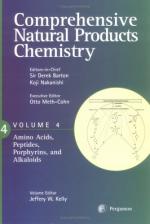|
This section contains 878 words (approx. 3 pages at 300 words per page) |

|
Amino acids, the building blocks of all protein molecules, are nitrogen-containing organic compounds that consist of at least one acidic carboxyl group (COOH) and one amino group (NH2). In alpha amino acids that are contained in the proteins found in cells, these two groups are both attached to a carbon atom, which also carries a hydrogen atom, plus a side chain known as the R group. The R group varies from one amino acid to another and gives each amino acid its distinctive properties. Although relatively simple compounds, amino acids can vary widely and to date more than 80 different amino acids have been found in living organisms. Of these 80 amino acids, 22 are considered the precursors of animal proteins.
Codons along the messenger RNA molecule (mRNA), synthesized from a DNA template, control the sequence of the insertion of amino acids into the protein chain during the process...
|
This section contains 878 words (approx. 3 pages at 300 words per page) |

|


